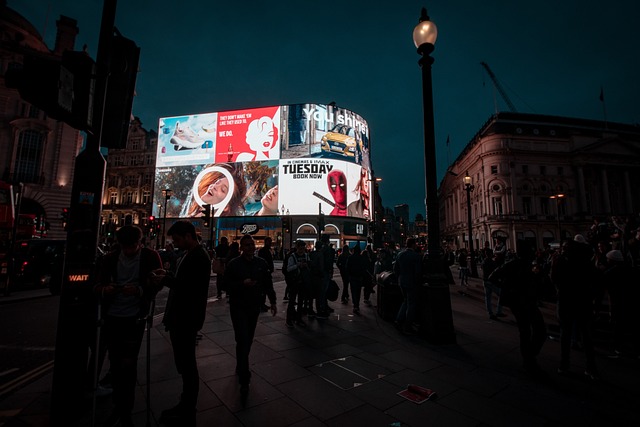
Outdoor advertising can be a powerful tool to help brands and businesses gain public attention. Billboards are a well-known marketing tool, but there are many other creative outdoor advertising options that are becoming more popular.
Wallscapes are a popular type of outdoor advertising. They can be used to advertise in areas where traditional outdoor advertising methods don't work. These can include tall buildings, construction sites, and garages.
Vehicle advertising is another type of outdoor advertising. This can be very effective and reach large areas of potential clients. This is especially beneficial for national and multi-location companies because the vehicles frequently travel through the day and into the evening spreading the advertising message.
There are many approaches to this type of advertising, but the most important is the design. Professional designers can help you stand out among the crowd and make sure your ads communicate your message effectively.

This is especially important if your target market is commuters or tourists. Make sure your outdoor ad is visible when they commute to work or visit the area.
Bridge banners can be a great way to advertise your business. They are especially useful for businesses targeting frequent travelers or commuters who use the bridge. Be sure to design a banner that is both large and attractive enough to catch the eye of people passing by the bridge while they commute.
Consider whether you would prefer to design your advertisement yourself or to outsource it. This affordable option can save you both time and money as well as ensure that your design is high-quality.
Another way to create a successful outdoor ad is to use social media. Campaigns that combine an engaging message and a fun, interactive component are the best. This can include anything from a live DJ to an augmented reality experience that allows users to interact with the brand's products and service.
It takes creativity and planning to create an outdoor advertising campaign that works. This includes choosing the right theme and determining the best location for your ads.

A successful campaign can be made or broken by the right outdoor advertising. This is why it's important to take the time to think about your business goals and how your ads can achieve those objectives.
This is a difficult part of choosing the type of outdoor advertising to use. It's worth speaking with professionals to get the best advice on what ads will succeed. For example, if your target market is women who love to exercise but don't like the idea of wearing performance clothing, you should consider making your outdoor ads more playful and whimsical.
FAQ
What is advertising's primary purpose?
Advertising is more about connecting with customers than just selling products.
Advertising is all about communicating ideas and values with people who are already interested. It's about changing people's attitudes. And it's about building relationships.
It's about helping people feel good about themselves.
However, if your customers don't want what you have to offer, you won't be able to sell anything.
So before you start any advertising project, you should first understand your customer's needs and wants, and buying habits.
Then, you can create ads that resonate.
What is an advert buyer?
Advertising space is purchased by an advertiser on TV, radio and printed media.
Advertisers pay for the time their message appears.
They don't necessarily look for the best advertisement, but instead seek out the most effective way to reach their target market.
An advertiser might have details about potential customers, including their age, gender and income.
Advertisers can use these data to determine the best medium for them. They might decide direct mail is more effective for older people.
Advertisers also evaluate the competition. Advertisers might place their ads near similar businesses if they see them.
Advertisers should also consider how much money they have available and how long it takes to use it.
How much does advertising on social media cost?
If you decide to go this route, you should know that social media advertising is not free. You'll be charged monthly according to how long you spend on each platform.
Facebook - $0.10 per 1,000 impressions
Twitter - $0.20/1000 impressions (if applicable)
Linkedin - $0.30 for 1,000 impressions if your send out invitations
Instagram - $0.50 for 1,000 impressions
Snapchat - $0.60 Per 1,000 Impressions ($0.40 per User)
YouTube - $0.25 Per 1,000 Views
Tumblr – $0.15 per 1000 impressions for text postings
Pinterest - $0.05 per 1,000 impressions per month
Google + $0.15-$0.20 for 1,000,000 impressions
Tumblr – $0.15 - $0.20 per 100,000 impressions
Vimeo – $0.20- $0.25 Per 10,000 Impressions
Soundcloud - $0.20 - $0.0.25 for 1,000,000 plays
StumbleUpon - $0.20 -$0.25 per 1 billion pageviews
Digg - $0.20 - $0.25 per 1000 diggs
Reddit - $0.20 - $0.0.25 per 1000 Comments
Wordpress $0.20-$0.25 per 500 Comments
Flickr - $0.20 -- $0.25 per 5,000 photo uploads
Social media is a great way to advertise your business.
Social Media Marketing (SMM) allows you to reach customers where they are - on social networks such as Facebook, Twitter, LinkedIn, YouTube, Google+, etc. You can also target specific segments within these networks with keywords.
Because this advertising method costs less online than traditional methods, it's more cost-effective. It allows you build strong relationships between your potential and existing clients.
It's easy to start using social media to promote your business. All you need is access to the Internet and a smartphone.
What should you know about printing advertising?
Print advertising is a good medium to communicate effectively with consumers. Print advertising is used extensively by companies to promote their products or services. It is designed to attract the attention of the customer.
Print ads are usually short (one page) and contain text, pictures, logos, and other graphics. You may also find sound, animation, video and hyperlinks.
The main types of print advertisements are classified as follows:
1. Brochures are large-format printed materials that are designed to draw people into shops. They often have colorful pictures and eye-catching designs.
2. Catalogues: These are smaller versions or brochures. They are typically sent to customers who have requested information on specific items.
3. Flyers - These small pieces of paper are distributed at events like fairs and concerts. They can be given at retail outlets but must be paid for.
4. Posters - These flyers can be larger than the ones you see on the flyer. They can be displayed on fences, walls, or buildings. These are often created with computer software programs to grab the attention of passersby.
5. Direct mail – These are direct mail letters and postcards sent to potential customers. These are sent periodically by companies to remind current customers about their business.
6. Newspaper Ads - These advertisements are found in newspapers and magazines. They can be quite lengthy and often include text as well as images.
What are the basics of television advertising?
Television advertising is an extremely effective medium for reaching many people at once. It was also very costly. However, if you use it well, it can be incredibly powerful.
While there are many types and styles of TV ads, most share some common traits. When planning any TV ad, the first thing you should do is ensure that it fits within its category. Do not attempt to run a lifestyle advertisement as a product advert. Your message should be consistent throughout the entire campaign.
It is important to remember that ads are best aired during prime-time. This is because viewers tend to watch TV while sitting down in front the television. They should be able to concentrate on what you are saying.
You don't have to be rich to achieve great results. However, this may not be true. A study conducted by the University of California found that commercials aired during popular shows were less likely to sell products than those aired during unpopular shows. If you spend a lot of money advertising on TV, make sure it's done right.
What are the basics of internet advertising?
Internet advertising has become an integral part any business strategy. It allows companies to reach potential customers at low costs. There are many options for internet advertising. Some are completely free while others require payment.
You can also advertise online using banner ads, pop up ads, search engine optimization, pay-per-click advertisements (PPC), social media marketing (e-mail marketing), and mobile marketing. Each method has its benefits and drawbacks.
Statistics
- Worldwide spending on advertising in 2015 amounted to an estimated US$529.43 billion. (en.wikipedia.org)
- In 1919 it was 2.5 percent of gross domestic product (GDP) in the US, and it averaged 2.2 percent of GDP between then and at least 2007, though it may have declined dramatically since the Great Recession. (en.wikipedia.org)
- Advertising's projected distribution for 2017 was 40.4% on TV, 33.3% on digital, 9% on newspapers, 6.9% on magazines, 5.8% outdoor, and 4.3% on radio. (en.wikipedia.org)
- This means that at least 50% of an ad needs to be shown on the screen for at least one second. (quicksprout.com)
External Links
How To
How to show ads on your website
An essential part of any company is advertising. They reach potential customers, and keep them coming back.
Advertisements allow you to promote products and services without spending money.
Google Adsense can be used to display image and text advertisements on your website, blog, forum, or any other online content.
Google Adsense lets you earn revenue for each click on the ad links on your website. It doesn't take any code to create your ads.
To get started, just sign up for a free account at www.google.com/adsense. These are the next steps:
-
Use the Ad Builder to create your ads. The tool allows you to create different ads such as text, images or interactive ads.
-
Once you have created your ads you will need to upload them into your AdSense account. To do this, select "Upload" under the "My Ads" section in the left-hand navigation bar.
-
Next, add keywords to describe your product or service to make sure your ads appear on search results that are relevant to your niche.
-
Copy and paste your ads to the relevant areas of your site. Once you've completed all of this, your ads are automatically uploaded to the website.
-
When visitors click on one of your ads, they'll be directed to another page on your site where they can purchase your products and services.
-
When someone clicks on an AdSense ad, earnings are transferred to your AdSense account.
-
Go to the My Account tab, located at the top of the AdSense dashboard. There you will find reports detailing the performance of your ads.
-
You can also save your earnings as CSV files.
-
You can modify your ads and target audience to increase your earnings.
-
Finally, ads can be paused or deleted at any time.
-
We are available to answer any questions.